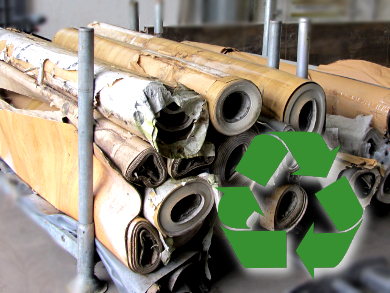PVC Use and Recovery
Polyvinyl chloride, or PVC, is the third most commonly used polymer after polyethylene (PE) and polypropylene (PP). In Europe, roughly 70 % of PVC is used in rigid form, e.g., for pipes or window frames. The other 30 % are combined with plasticizers to make the material flexible for applications such as PVC flooring, electrical insulation, and PVC coatings [1]. The most frequently used plasticizers are phthalic acid esters. However, due to health and safety concerns, the production and use of some low molecular weight phthalates have been restricted in the European Union and alternative plasticizers, such as high molecular weight phthalates, have been gaining market share.
PVC products often have a long lifespan, however, if PVC waste is deposited in landfills or incinerated, additives – such as phthalates or the heavy metals lead and cadmium – can be released into the environment. To reduce the environmental impact and improve the material’s sustainability, the European Union has developed a set of rules, banning PVC from disposal in landfills and encouraging its recovery and reuse. As a result, the European PVC industry has come up with a voluntary commitment program, VinylPlus (formerly Vinyl 2010), to promote the efficient use of PVC and the sustainable use of additives. One aim of the program is to recycle 800,000 t/year of PVC by 2020. In 2015, the network achieved an amount of 514,913 t of recycled PVC [2].
Recycling PVC Floors
As one part of these recycling efforts, a number of European PVC flooring producers have founded AgPR (Association for the Recycling of PVC Floor-Coverings) in 1990. AgPR operates a recycling plant in Troisdorf, Germany, with a capacity of 4,000 – 5,000 t/year. PVC flooring waste is collected, sorted, cleaned, and broken down to finely ground PVC particles which can be reused, e.g., in new PVC floorings.
 |
1Used PVC flooring is collected and delivered to the recycling plant. |
.jpg) |
2
|
 |
3
|
 |
4
|
 |
5
|
6
|
|
 |
7
|
The Future for PVC
PVC, like all of today’s most commonly used plastics, depends on ever-depleting oil reserves for its production. However, it will in all probability be in use for quite some time, since it is comparatively cost-effective and energy-efficient to manufacture and process, almost indispensable in some specialty applications (such as IV tubing and blood bags), and relatively easy to recycle.
To reduce the material’s impact on the environment, minimizing waste and promoting reuse and recycling are important aspects that need to be combined with replacing potentially harmful additives and improving energy efficiency in manufacturing processes. While some steps in this direction have already been taken, e.g., recycling projects like AgPR or phasing out lead stabilizers in European PVC production [3], there still is potential for further innovations.
References
[1] Everything about PVC: From Manufacturing to Recycling, PVCplus, 2012.
[2] VinylPlus Progress Report 2016, VinylPlus, 2016.
[3] Lead Replacement, European Stabiliser Producers Association (ESPA). (accessed July 25, 2016).
- AgPR (Arbeitsgemeinschaft PVC-Bodenbelag Recycling), Troisdorf, Germany
- VinylPlus, Brussels, Belgium
Also of Interest
- Plasticizers – Benefits, Trends, Health, and Environmental Issues,
Vera Koester,
ChemViews Mag. 2015.
DOI: 10.1002/chemv.201500028
Dr. Stéphane Content, ECPI, on one of the most widely researched chemical substances




